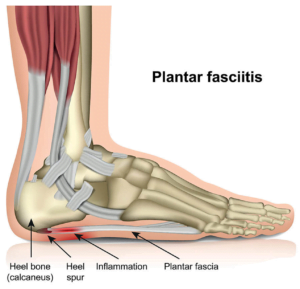“My heel and feet hurt first thing when I get up in the morning or after sitting for a period of time, often gets worse during the day”
What is the Plantar Fascia?
The Plantar Fascia is a thick band of connective tissue on the bottom of your foot that attaches to the heel bone and runs along the bottom of the foot to the forefoot. The plantar fascia acts as a “spring” to support the foot when walking, running and jumping. The Plantar fascia is designed to help absorb shock and push you forward when walking.

What is Plantar fasciitis?
Plantar fasciitis is one of the most common causes of heel and foot pain and can present in different ways. Pain from plantar fasciitis can be present anywhere along the main arch of the foot or can be present directly under the heel. Plantar fasciitis is inflammation/swelling of the plantar fascia often associated with micro tears within the soft tissue of the fascia. Plantar fasciitis can also be a result of inflammation and pain at the attachment sites on the heel bone.
What are the symptoms?
The most common clinical symptom of plantar fasciitis we see is a sharp pain under the heel or arch when you take your first few steps in the morning that gets better with time. Other symptoms can include an ache in the arch or burning sensation after prolonged standing or sitting and pain upon rest at the end of the day. Often the heel or inside of the arch can become swollen and hot to touch also.
What causes Plantar Fasciitis?
Plantar fasciitis is caused by an increase in force and stress along the plantar fascia. Repeated stretching or overuse can cause the soft tissue to tear or become inflamed. This repeated stress can also result in minor micro tears in mild cases but in extreme cases result in complete rupture of the plantar fascia. There are a number of risk factors that contribute to the development of plantar fasciitis.
These include:
- Sudden increase in exercise
- Poor quality or fitting footwear
- Age – the most common age to develop plantar fasciitis is between 35 and 65.
- Foot mechanics – people with a flatter foot or high arch are more likely to develop plantar fasciitis.
- Occupation – people who work long hours on hard and/or uneven surfaces are more likely to develop plantar fasciitis. For example, factory workers, nurses, teachers and builders.
What is the treatment of Plantar Fasciitis?
The first line of treatment involves reducing your symptoms by treating the inflammation that’s causing your pain. This involves icing the region, exercises to help with residual inflammation and stretches to address your individual mechanics. Your podiatrist will also likely trial some padding if they deem it necessary to look for improvements with your symptoms.
The next step in the treatment process is looking at your overall mechanics by assessing your individual biomechanics and the forces at which your feet are subject to. From there your podiatrist can recommend appropriate footwear and prefabricated or custom orthotics depending on your individual treatment plan.
Along with these interventions our podiatrists also have access to the latest shockwave technology to help further treat your symptoms, depending on your individual circumstances.
If left untreated Plantar fasciitis can progress in a couple of ways;
In serious instances plantar fasciitis can result in complete rupture of the soft tissue structures often resulting in the need for surgery. If mild plantar fasciitis is left untreated for a long time it can become a chronic condition that changes the soft tissue structures into what is described as “heel spurs”. This progression can become increasingly difficult to treat the more chronic it becomes.
If you are suffering from the symptoms of plantar fasciitis, book an appointment to see one of our heel pain experts today.
